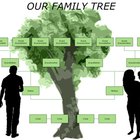
Every name has a history. You can trace the history of your name to find its origin and meaning or to build a family tree. You can use genealogy to research your family's history and find out about your ancestors. While tracing the history of a name takes time, online genealogy resources can assist you.
Interview your relatives to gather as much information as possible. Talk to your parents, aunts and uncles, grandparents and cousins. Collect the following information about each family member: complete name; maiden name; addresses; birth date; place of birth; marriage dates and locations; and date and place of death of deceased relatives.
Ask older relatives if they have any old letters or family bibles that might contain useful information about prior generations. Ask if they have old photographs of distant relatives. Check to see if any names are written on the backs of the photographs.
Make a list of information your relatives could not provide. Search public records for birth and death records of your ancestors. Search the vital statistics registry for birth certificates and death certificates in the states in which the relative resided. Look for genealogy resources in the National Archives and Records Administration at Archives.gov.
Look for existing family trees in online genealogy sites such as Familytreesearcher.com, Ancestry.com and Genealogy.com. It is possible that someone else has traced your family tree and posted it on one of these sites.
Search for family pedigrees to see if another family's research is linked to your family tree. Two examples of family pedigree websites are Interment.net and Familysearch.org.
Go to local libraries in towns where your ancestors lived to look for birth announcements, marriage announcements and obituaries in old newspaper records. Research online newspaper archives for more recent records. Review the announcements for names of relatives.
Review the birth and death certificates of your ancestors to find the names of their fathers and mothers. Search for Federal Census records if they lived in the United States between 1790 and 1930. Ancestry.com has an online Federal Census database that you can search for a fee, using only the names.
Use the interactive search at Rootsweb.com to search the Social Security Death Index (SSDI) for death records of people who died after 1962.
Research naturalization records of the Immigration and Naturalization Service (INS) at Archives.gov for ancestors who were immigrants.
Meta description:
You can trace the history of a name mostly online. But interviewing older, living relatives can provide a treasure trove of information, too.
Related Articles

How to Find Ancestry in Singapore

How to Find Out Where Your Family Came ...

How to Trace Your Family Tree for Free

How to Find Out Who You're Related to ...

How to Find Your Bloodline

How to Find School Records for Family ...

How to Find Lost Relatives

How to Find Someone's Birth City & ...

How to Find Out If a Family Member Has ...

How to Find Obituaries From Over 10 ...

How to Map German Surnames

How to Search for Japanese Ancestors ...

How to Find an Obituary

How to Find Someone's Relatives

How to Find Birth Parents for Free

How to Find Siblings Using the Birth ...

How to Search for Relatives in Other ...

How to Design a Family Tree for Free

How to Find an Old Friend in Canada

How to Find Your Dad That You Have ...
References
Resources
Tips
- Use genealogy message boards to search for information about your family tree, and share your genealogy research with others.
Writer Bio
Sharon Guy is a freelance writer and attorney. She has been writing for law firms, businesses and nonprofit organizations since 2000. She holds a Juris Doctorate from Quinnipiac University School of Law and a Bachelor of Arts in fine art from Bard College.
Photo Credits
bible image by pearlguy from Fotolia.com